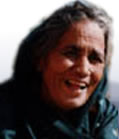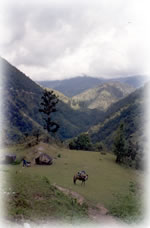 |
 |
||
 |
|||
|
RELATED THEMES agriculture environmental knowledge forestry spiritual beliefs water OTHER LOCAL THEMES BACKGROUND |
environment
Plant and animal species have also been affected by human encroachment into remote areas, unsustainable harvesting of plants, and new agricultural practices which demand herbicides, hybrid seeds and chemical fertilisers. The latter works well in the short term, many say, but in the long term the soil becomes hard and unproductive. Road construction affects the environment significantly - not just by taking up land but by destabilising steep slopes and increasing vulnerability to landslides and erosion. Many speak of climate change ("in our times alone the Gaumukh glacier has receded by 10 to 12 metres," says one). Almost without exception, people say the rains are more erratic and that overall rainfall has declined. People say the rains aren't being "attracted" to the region anymore because of the lack of trees, and that when rain does fall, there are far fewer trees with thick roots to retain the water. Although the cataloguing is more of species lost or in decline, some do remark upon the intentional or otherwise introduction of new plant species. Several complain that the new hybrid seeds brought with them different weeds or grasses that have overtaken traditional, more useful varieties. One woman talks about how the shrub lantana has spread rapidly in their region and now they have little choice but to use it for fuelwood whereas once they laughed at other people for so doing because its thin stems give out more smoke than anything else. "Women of Bandarkot used to take lantana wood for burning. We used to make fun of them when they took that wood. Now, even we bring this bush for burning because all other bushes have vanished. It is a useless bush. people from somewhere outside have brought it here." (India 34) Another striking feature about the environment in these testimonies is the powerful sense of the strong links between people's spiritual worlds and their physical environment. Many of the religious rituals or festivals described are about celebrating the sacred in the surrounding natural resources. Such actions demonstrate people's deep respect for the importance of the water, earth, plants and animals that sustain them, and they also translate into practical concepts: several narrators are convinced that only when development policies take full account of the importance of the environment will there be any chance of sustainability. "Until we link the environment with development, we cannot talk of the right kind of development," says Jagat (India 10). But, he goes on to say, the new generation prefer to think about the environment "only after taking care of their stomachs, of unemployment, of economic resources." quotes about environment"What we have heard from people before us was that there was no shortage of fodder in their times. Nature had given them enough but now the jungle is under pressure from the population and it has lessened. Fodder trees have been replaced by pine. The jungle has become commercial and the availability of fodder has vanished." "Mountains and rivers of this area shouldn't be exploited for material development. Massive road construction has also caused tree felling, increased soil erosion and landslides in this area. These should be touched in emergencies only." "With the thinning and stripping of the forests the animals here moved.into the area where the forests are thick and lush.Stags and deer are disappearing slowly. The elephants in the valleys are also decreasing... Birds like munal (Himalayan pheasant), partridges, quail are also disappearing.with the increasing population..." "Earlier it used to snow in December, in Dunda as well as at Harsil. But this year in December the rains have not even started in Harsil. When we sow the seeds, it does not rain.The timing has gone wrong. It rains at the time of harvest, which causes great loss." |
|
 The overriding impression to emerge from these testimonies is that the environment is changing more significantly and at a faster rate than any narrators can remember. The dense broad-leaved forests of the lower valleys and the high altitude meadows have long been a rich source of edible and medicinal plants, and shrubs, trees and grasses which give fibre for ropes etc, hard woods resistant to insects, oils, cane for weaving, and dyes for textiles. But loss of tree cover has reduced the availability of all such forest products, as well as fuelwood and fodder. Forests are being lost primarily because of logging (commercial and small-scale), but also from road building and increased cultivation. The nature of the forest has been changing too, though some of this - the imposition of a single species for greater profit - stems from decades-old forestry policies. This single species is often pine, which dramatically reduces the surrounding biodiversity since few plants thrive alongside it. Overall, the reduction in forest density and diversity is probably the single most important environmental change in the region.
The overriding impression to emerge from these testimonies is that the environment is changing more significantly and at a faster rate than any narrators can remember. The dense broad-leaved forests of the lower valleys and the high altitude meadows have long been a rich source of edible and medicinal plants, and shrubs, trees and grasses which give fibre for ropes etc, hard woods resistant to insects, oils, cane for weaving, and dyes for textiles. But loss of tree cover has reduced the availability of all such forest products, as well as fuelwood and fodder. Forests are being lost primarily because of logging (commercial and small-scale), but also from road building and increased cultivation. The nature of the forest has been changing too, though some of this - the imposition of a single species for greater profit - stems from decades-old forestry policies. This single species is often pine, which dramatically reduces the surrounding biodiversity since few plants thrive alongside it. Overall, the reduction in forest density and diversity is probably the single most important environmental change in the region.